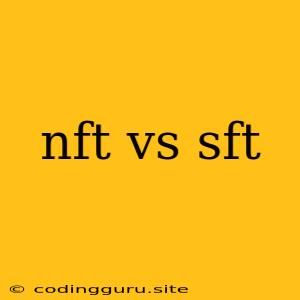NFT vs SFT: Understanding the Differences Between These Digital Assets
In the rapidly evolving world of digital assets, two prominent acronyms have emerged: NFT (Non-Fungible Token) and SFT (Semi-Fungible Token). While both represent digital representations of ownership, they differ significantly in their characteristics and applications. Understanding these differences is crucial for anyone interested in navigating the dynamic landscape of digital assets.
What is an NFT?
NFT stands for Non-Fungible Token, signifying a unique and irreplaceable digital asset. Think of it as a digital certificate of authenticity for a specific piece of digital content. Each NFT is unique, just like a physical painting or a piece of art. This uniqueness stems from its underlying technology, typically based on a blockchain like Ethereum.
What is an SFT?
SFT, or Semi-Fungible Token, offers a unique twist to the concept of fungibility. Unlike NFTs, SFTs allow for partial ownership or fractionalized ownership of a digital asset. This means you can own a portion of a larger asset, such as a piece of digital real estate or a share in a digital artwork.
Key Differences Between NFT and SFT:
- Fungibility: NFTs are non-fungible, meaning they are unique and irreplaceable. SFTs, on the other hand, are semi-fungible, allowing for partial ownership.
- Ownership: NFTs represent complete ownership of a digital asset. SFTs allow for fractionalized ownership, with multiple parties owning parts of the same asset.
- Applications: NFTs are widely used for digital art, collectibles, gaming items, and even real-world assets. SFTs are emerging in areas like fractionalized ownership of real estate, digital assets, and investment opportunities.
Advantages of NFTs:
- Uniqueness and Scarcity: NFTs offer unparalleled uniqueness and scarcity, making them highly desirable for collectors.
- Authenticity and Proof of Ownership: The blockchain technology underlying NFTs provides irrefutable proof of ownership.
- Potential for Investment: NFTs can be traded and exchanged, potentially generating returns for investors.
Advantages of SFTs:
- Accessibility: SFTs allow individuals to invest in assets that might otherwise be inaccessible due to high costs.
- Fractionalized Ownership: This feature opens up new avenues for investment and participation in previously exclusive markets.
- Diversification: SFTs can help diversify investment portfolios by allowing individuals to invest in different assets.
Examples of NFT and SFT Applications:
NFTs:
- Digital Art: NFTs have revolutionized the digital art market, allowing artists to sell their creations directly to collectors.
- Collectibles: Trading cards, video game items, and other digital collectibles are popular examples of NFT applications.
- Real-World Assets: NFTs can represent ownership of real-world assets such as property, tickets, or even physical artwork.
SFTs:
- Fractionalized Real Estate: SFTs allow individuals to invest in real estate properties by owning a fraction of them.
- Digital Asset Ownership: SFTs enable fractional ownership of digital assets such as shares in a company or a portion of a digital artwork.
- Investment Opportunities: SFTs offer opportunities for investors to diversify their portfolios and gain exposure to different asset classes.
Conclusion:
NFT and SFT are distinct but complementary digital assets that cater to diverse needs. NFTs offer uniqueness, scarcity, and proof of ownership, making them ideal for digital art, collectibles, and other limited-edition items. SFTs provide accessibility, fractionalized ownership, and diversification opportunities, opening up new frontiers in investment and asset ownership. Understanding the differences between these two types of tokens is essential for navigating the evolving landscape of digital assets.
